Home
History
Historic Maps
Agricultural Census Data
Survey Map
Photos
Resources
Vermont Barn Census
Chittenden County Barns
|
An Agricultural History of Charlotte, Vermont
Agriculture has always been a way of life in the Champlain Valley of northwestern Vermont. Among the mountains and Lake Champlain, the fertile soil has supported farmers for generations. Charlotte, Vermont, located along Lake Champlain’s eastern shore in the southern tip of Chittenden County, is no exception.
 
Chartered and named by George III of England in 1762, Charlotte’s charter was granted by New Hampshire’s royal governor Bennington Wentworth on the twenty-fourth of June in the same year.(1) The chartered land was given to proprietors, mostly from New York, yet few, if any, actually settled it. For many years, the land was not inhabited by anyone. Derick Webb made his first attempt in 1776 but was not prepared and soon left. Then in 1784, Webb returned with Elijah Woolcott. (2)These two become the first permanent settlers with others, such as James Hill, David Hosford, Moses Fall, John Hill, and Dr. James Towner, soon to follow.(3)
When the first settlers arrived, the lack of roads or other transportation routes made travel difficult but in just a few years many had made the strenuous journey to call Charlotte their new home. On March 3, 1787, the town was officially organized and the first complete census revealed that Charlotte had grown to become the most populous town in the northern half of Vermont with 635 residents.(4)
The rich and fertile soil of the Champlain Valley pulled the settlers in and provided the newcomers with an obvious occupation choice. From the very start, the settlers of Charlotte were farmers. Subsistence farming prevailed at first but as time passed and the settlers became more established in their new town, more farmers specialized. Following the trends, it is evident that raising sheep and selling their wool was profitable before giving way to, the still popular, dairy production.
In addition to farming, a few residents tried their hand at other trades. Alanson Edgerton’s Cider Mill, Winfield Scott’s Saw and Grist Mill, and H.D. Alexander’s Vineyard and Fruit Farm were all businesses listed in the 1882-83 Hamilton Child’s Gazetteer and Business Directory of Chittenden County, Vermont.(5) Three stores scattered throughout the town were also successful. Furthermore, the first ferry service across Lake Champlain originated in Charlotte, established by John McNeil in 1790.(6) Initially, the ferry service consisted of sailboats but as McNeil gained success he replaced the wind power of the sails with horse power generated by horses walking on treadmills.(7)
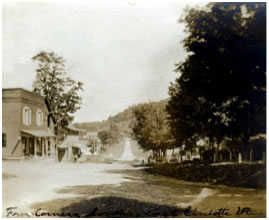 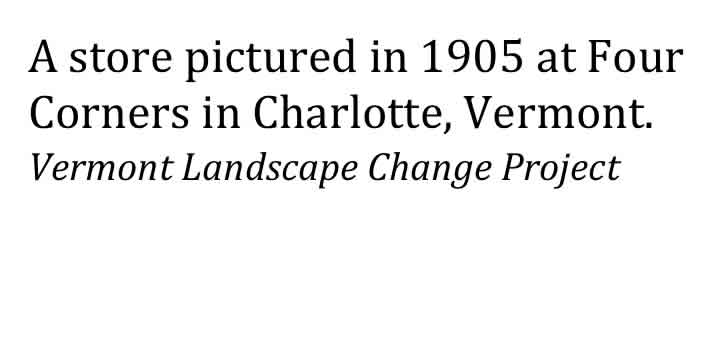
As stated before, agriculture has been a way of life in Charlotte since the first settlers arrived. Once Charlotte had been officially organized, the town’s population grew rapidly. By 1830, 1,702 people called Charlotte home, most living and working on their own farms.(8) The state was in the midst of the Merino Sheep boom that lasted from around 1815 to 1840.(9) Charlotte benefited from the wool boom greatly and some of her farmers would continue to benefit well after the wool boom was over.
After 1840, the Merino wool industry moved to other areas around the globe such as South American and New Zealand. This evidence can be found in the US Agriculture Census data from 1840-1880. In 1840, the farmers of Charlotte were keeping 5, 815 sheep, dropping to 2,940 in 1860 and only 1,698 in 1880.(10) While many farmers were moving away from the Merino sheep some, like Henry Thorp, continued in the breeding business. Listed in Child’s Gazetteer in 1882-83, Thorp was a “breeder of fine blood Atwood Merino sheep.”(11) Today Henry Thorp’s barn still stands, and is located along the western side of the Ethan Allen Highway. Built in the late eighteenth century, this surviving example illustrates changes in agriculture traditions through its modifications and additions.(12) Like Thorpe many of those that held sheep in 1880 were breeders, shown in the wool production numbers dropping from 31,368 pounds of wool in 1840 to only 10, 299 pounds in 1880.(13)
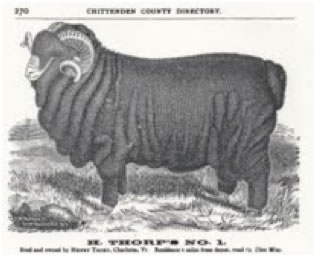 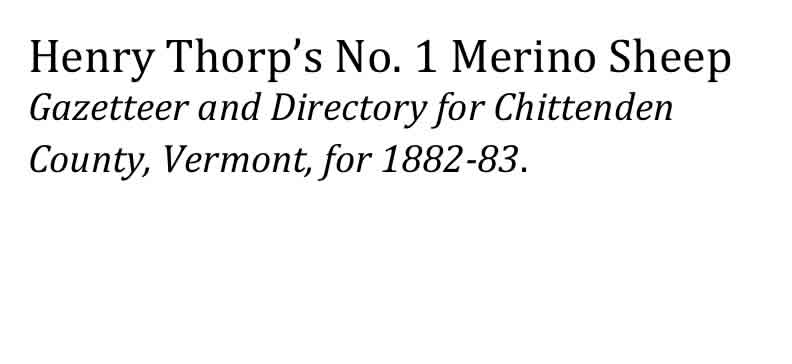
As the Merino sheep faded from the spot light, dairy production became the new driver of Charlotte’s economy and this trend continues today. By 1860, dairy farming had already taken hold and the number of dairy cows did not increase very much from 1860 at 1,749 cows to 1,776 in 1880.(14) However, between 1860 and 1880 the production of dairy products changed with the invention of the refrigerated railroad car. In 1860 butter and cheese production were very similar with 159,170 pounds and 158,862 pounds respectively.(15) By 1880, butter had risen by about 35,000 pounds, but cheese dropped to a low of 14,100 pounds.(16) Milk production remained the same but the invention of the refrigerated railroad car allowed liquid milk to be transported to cities farther removed from northern Vermont. This caused the sharp decline in cheese production but added 128,780 gallons of liquid milk to Charlotte farmers’ production numbers.(17) Dairy production has continued throughout the 19th, 20th and 21st centuries. In 1945, the agricultural census showed that 78% of farms in Charlotte owned dairy cows.(18)
In addition to sheep farming and dairy production, farmers in Charlotte grew other crops for sale and for feed for their animals. In 1840, 52,985 bushels of potatoes were grown but throughout the century production dropped to 11,877 bushels in 1880.(19) Oats, used as feed for the livestock, increased from 18,000 bushels in 1840 to 24,944 bushels in 1880 as the number of dairy cows increased.(20) Other specialty crops show trends as well. The production of honey increased about 1,500 pounds from 1860 to 1880 but was concentrated to just a few farms throughout the area, showing evidence that farmers were continuing to specialize their agricultural productions.(21)
Other evidence of the importance of agriculture in Charlotte can be found in the history of Thompson’s Point. On this point along the Lake Champlain shoreline, the town acquired a farmstead in 1846 so to create a ‘Poor Farm’ for the impoverished citizens of the town to live and work.(22) The Poor Farm was used until the 1940s.
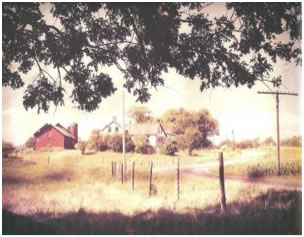 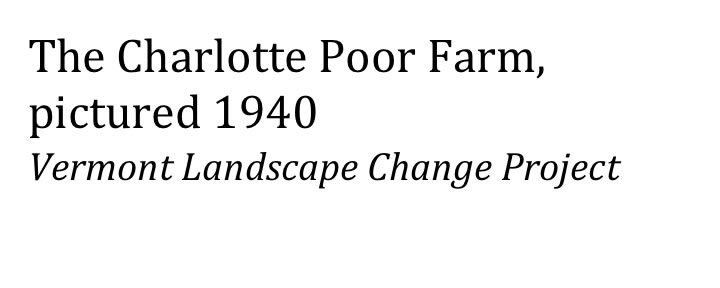
In conclusion, it is evident that agriculture has been a way of life in Charlotte, Vermont. It began as a way to survive in the newly settled town and has continued throughout the three centuries of Charlotte’s history. As it was two hundred years ago, farming is still the driving force of the town’s economy. Sheep farming and wool production, which continued longer in Charlotte than other areas of Vermont, began the specialization. This activity then gave way to dairy production that is still being practiced today. Although the numbers of farms themselves have decreased, from 200 in 1860 to 143 in 1945(23), the passion for agriculture and production of fine agricultural goods is still evident as you travel through the beautiful town of Charlotte, Vermont.
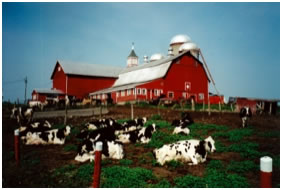 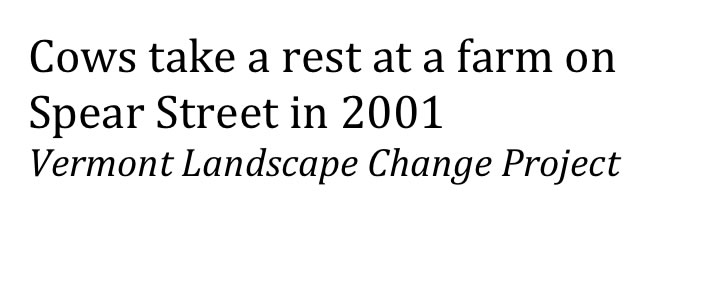
|
Footnotes
1 [Committee for the Celebration], Charlotte, 1762-1962, (Charlotte Historical Society, 1962?).
2 Ibid.
3 Ibid.
4 Ibid.
5 Hamilton Child, “Town of Charlotte,” Gazetteer and Directory for Chittenden County, Vermont, for 1882-83 (Syracuse: Hamilton Child), 1882-1883.
6 Ibid.
7 Ibid.
8 Kevin Thornton. “A Cultural Frontier: Ethnicity and the Marketplace in Charlotte, Vermont, 1845-1860.” Cultural Change and the Market Revolution in America, 1789-1860, ed. by Scott C. Martin (Lanham: Rowan and Littlefield Publishers, Inc., 2005), 48.
9 Ibid.
10 United States Census Bureau. Productions of Agriculture in the Town of Charlotte, Chittenden County, Vermont. 1840, 1860, 1880.
11 Hamilton Child, Gazetteer and Directory for Chittenden County, Vermont, 1882-83, 272.
12 “The Thorp Barn in Charlotte, VT,” Charlotte Vermont, http://www.charlottevt.org/index.asp?Type=B_BASIC&SEC={C2E47B10-7DF5-41F6-8A91-3635CB972B12}.
13 US Census Bureau, Productions of Agriculture in the Town of Charlotte, 1840, 1860, 1880.
14 Ibid.
15 Ibid., 1860.
16 Ibid., 1880.
17 Ibid.
18 United States Census Bureau. Productions of Agriculture in the Town of Charlotte. 1945.
19 US Census Bureau, Productions of Agriculture in the Town of Charlotte, 1840, 1860, 1880.
20 Ibid.
21 Ibid.
22 Vermont Landscape Change Project. University of Vermont. http://www.uvm.edu/landscape/menu.php.
23 Ibid, 1860, 1945. |
Bibliography
Carlisle, Lilian Baker, ed. Look Around Hinesburg and Charlotte, Vermont. Burlington: Chittenden County Historical Society, 1973.
Child, Hamilton. Town of Charlotte, Gazetteer and Directory for Chittenden County, Vermont, for 1882-83. Syracuse: Hamilton Child, 1882-1883.
[Committee for the Celebration]. Charlotte, 1762-1962. [Charlotte Historical Society], 1962?.
Higbee, William Wallace. Around the Mountains: Historical Essays about Charlotte, Ferrisburgh, and Monkton. Comp. Kathleen McKinley Harris and Mary G. Lighthall. Charlotte: Charlotte Historical Society, 1991.
“The Thorp Barn in Charlotte, VT,” Charlotte, Vermont, http://www.charlottevt.org/index.asp?Type=B_BASIC&SEC={C2E47B10-7DF5-41F6-8A91-3635CB972B12}.
Thompson, Zadock. History of Vermont: Natural, Civil and Statistical. Vermont: Stacy and Jameson, Printers. 1853.
Thornton, Kevin. “A Cultural Frontier: Ethnicity and the Marketplace in Charlotte, Vermont, 1845-1860.” Cultural Change and the Market Revolution in America,1789-1860, edited by Scott C. Martin, 47-69. Lanham: Rowan and Littlefield Publishers, Inc., 2005.
United States Census Bureau. Productions of Agriculture in the Town of Charlotte, Chittenden County, Vermont. 1840. Microfilm.
United States Census Bureau. Productions of Agriculture in the Town of Charlotte, Chittenden County, Vermont. 1860. Microfilm.
United States Census Bureau. Productions of Agriculture in the Town of Charlotte, Chittenden County, Vermont. 1880. Microfilm.
United States Census Bureau. Productions of Agriculture in the Town of Charlotte, Chittenden County, Vermont. 1945.
Vermont Landscape Change Project. University of Vermont. http://www.uvm.edu/landscape/menu.php. |
|










